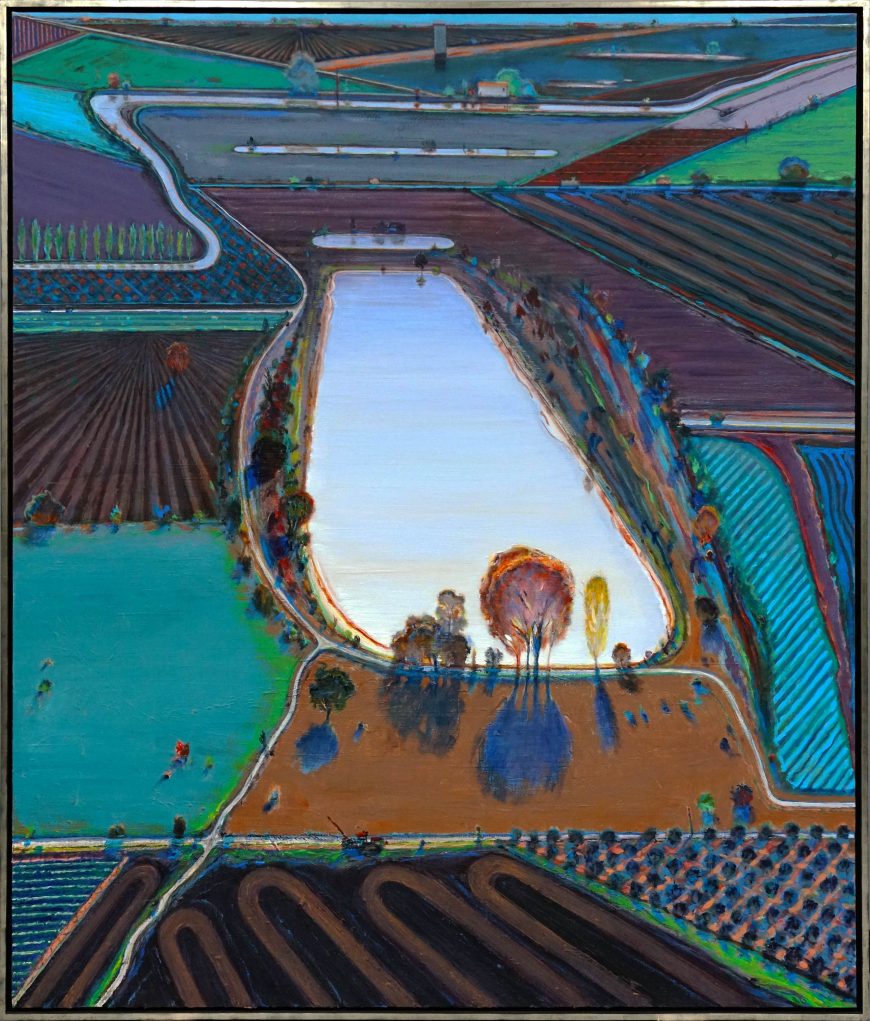A visit to the Valley today reveals a land that has undergone more transformation over the past 150 years than it experienced over the previous many centuries. It has seen people – cultural communities – from around the world converge on it. It has seen settlements emerge along railroad lines, silos and packing houses rise up, stretches of highway create corridors, and beautifully engineered rows of crops, acres of orchard and miles of irrigation canal create a new kind architecture – a thoroughly man-made one.
Fresno Historical Society, “Description of the San Joaquin Valley”
Wayne Thiebaud, Ponds and Streams, 2001 will be useful for the study of:
- The preservation and development in rural America in art and history
- Engineered farmland (irrigation, pesticides, migrant labor)
By the end of this lesson, students should be able to:
- Apply the tools of visual analysis to support interpretation of the artwork
- Discuss the transformation of an ordinary working landscape into a vivid image of beauty
- Understand that the rural landscape can be reshaped to become productive
1. Look closely at the painting

Wayne Thiebaud, Ponds and Streams, 2001, acrylic on canvas, 182.9 x 152.4 cm (Fine Arts Museums of San Francisco, ©Wayne Thiebaud)
Look closely at Thiebaud, Ponds and Streams, 2001 (downloadable images available for teaching)
Questions to ask:
- Look closely and describe what you see — what is man made and what is natural? How can you determine what is natural and what is not?
- Can you tell what season it is? What the weather is like?
- Based on how the painting is composed, what has the artist chosen to focus on? What has he mostly left out?
- What is our viewpoint in relationship to the landscape? Does it change, is this relationship consistent?
- How does the artist use color? What colors does the artist put next to each other? Do any of the colors attract your eye? Do other colors elicit other reactions?
2. Watch the video
The Seeing America video about Thiebaud’s Ponds and Streams, 2001 is less than five minutes in length. Ideally, the video should provide an active rather than a passive classroom experience. Please feel free to stop the video to respond to student questions, to underscore or develop issues, to define vocabulary, or to look closely at parts of the painting that are being discussed. Key points, a self-diagnostic quiz, and high resolution photographs with details of the work are provided to support the video.
3. Read about the painting and its historical context
An important example of Thiebaud’s late farmscapes, Ponds and Streams depicts a patchwork of plowed fields and shimmering waterways from a bird’s-eye vantage, with a barely visible horizon. Poised between representation and abstraction, the painting is composed of carefully constructed geometries and nonrepresentational colors that recall the artificial pastels of the artist’s painted confections. The California landscape—traditionally a symbol of nature at its most pure and bountiful—is presented as a completely cultivated site sustained only through an extensive network of artificial irrigation systems and chemical fertilizers. It is fitting that this stunningly beautiful meditation on the California landscape is a gift to the Museums from Richard and Rhoda Goldman, who were lifelong advocates for the care and protection of the environment, and founders of the Goldman Environmental Prize. Through the extraordinary generosity of the Goldmans, Ponds and Streams joins four paintings and more than 300 works on paper in the Museums’ collection of works by Thiebaud.
From The Fine Arts Museums of San Francisco
4. Discussion question
Watch the Seeing America video about Albert Bierstadt’s painting of the Hetch Hetchy Valley. In what ways does Thiebaud’s painting not fit with the idea of a beautiful American landscape?
5. Research question
Thiebaud has said, “My own sense is being American is a very important part of what I feel and do.” Look at other work by this artist. Does his statement make sense? What about his work seems “American”? (Smithsonian Magazine)
6. Bibliography
Mark Arax, “A Kingdom from Dust” The California Sunday Magazine (January 31, 2018)
Wayne Thiebaud in the Fine Arts Museums of San Francisco
Oral history interview with Wayne Thiebaud, 2001 May 17-18 (Archives of American Art)
Elson Lecture 2000: Wayne Thiebaud: “The Painted World” (National Gallery of Art)
Conversations with Artists: Wayne Thiebaud (National Gallery of Art)
Mark Bittman, “Everyone Eats There,” The New York Times Magazine (October 10, 2012)
Kenneth Baker, Nicholas Fox Weber, Karen Wilkin, and John Yau, Wayne Thiebaud (Rizzoli, 2015).
John Yau, California Landscapes: Richard Diebenkorn / Wayne Thiebaud (Rizzoli, 2018).


